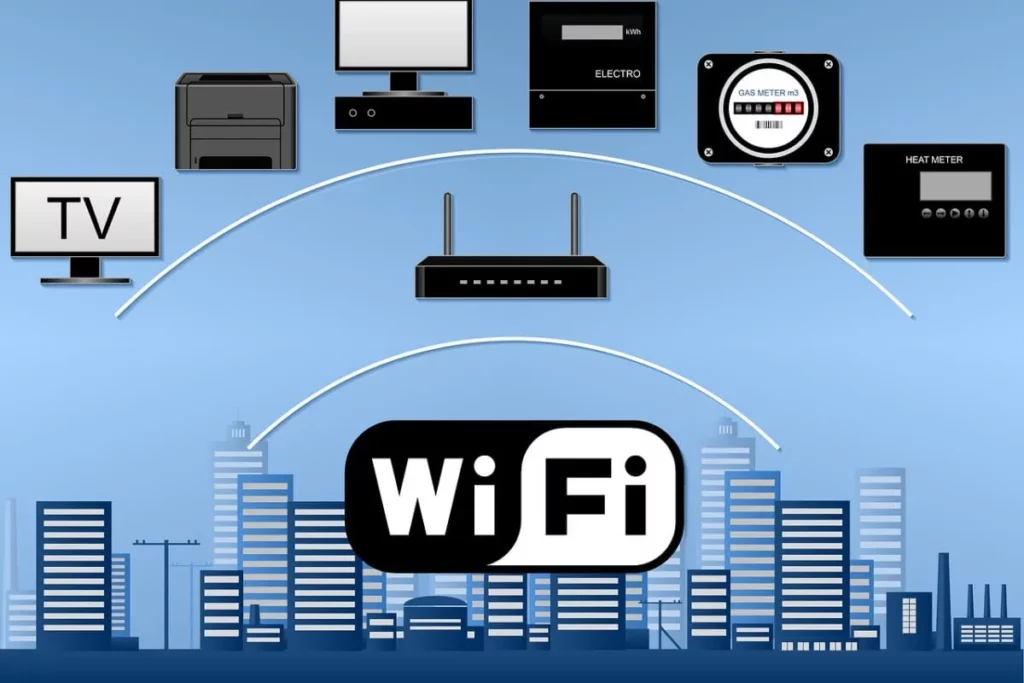A Deep Dive into WiFi Security: Protecting Your Digital Fortress

In today’s connected world, WiFi is the backbone of our digital lives. We use it at home, in the office, and on the go to access the internet, communicate, and work. While WiFi provides convenience and flexibility, it also comes with a set of security challenges. Ensuring your WiFi network is secure is paramount to safeguarding your data and privacy. In this blog, we’ll take a deep dive into the realm of WiFi security, exploring different aspects, vulnerabilities, and advanced measures to fortify your digital fortress.
Understanding WiFi Security

Before we dive into the intricacies of WiFi security, it’s essential to understand why it matters and what’s at stake. WiFi security involves the implementation of protective measures to keep your wireless network safe from unauthorized access, cyber threats, and data breaches.
The Importance of WiFi Security
WiFi has revolutionized the way we connect, but it has also introduced a new set of vulnerabilities. Here’s why WiFi security is of paramount importance:
Data Protection
In an era where we share sensitive information over WiFi, protecting your data is vital. WiFi security prevents unauthorized individuals from intercepting your data and potentially misusing it.
Privacy Preservation
Your WiFi network can be an open window into your digital life. Without proper security, others can invade your privacy, monitor your online activities, and compromise your personal information.
Device Safety
All the devices connected to your WiFi network are at risk if the network itself is insecure. Hackers can infiltrate your devices, potentially causing significant damage.
Network Reliability
A secure network is a reliable network. WiFi security ensures that your network functions optimally without interruptions caused by unauthorized access or cyberattacks.
WiFi Security Protocols

WiFi security is primarily based on the type of encryption and authentication protocols used. Over the years, various protocols have been developed, each with its level of security. Let’s explore the most prominent ones:
WEP (Wired Equivalent Privacy)
WEP was one of the first encryption protocols for WiFi networks. However, it quickly became obsolete due to its vulnerabilities. WEP relies on a single static key for encryption, making it easy for hackers to crack the code. As a result, it’s highly discouraged to use WEP for WiFi security.
WPA (WiFi Protected Access)
Recognizing the weaknesses of WEP, the WiFi Alliance introduced WPA as a more secure alternative. WPA uses dynamic keys, making it significantly harder to crack. WPA was a substantial improvement but is still considered outdated in comparison to its successors.
WPA2
WPA2, an upgrade from WPA, employs the Advanced Encryption Standard (AES) for stronger encryption. This protocol is widely used today and is considered secure for most home and business WiFi networks. WPA2 is recommended for its robust protection against most hacking attempts.
WPA3
WPA3 is the latest and most secure WiFi security protocol. It enhances encryption and protection against brute-force attacks. WPA3 is designed to meet the stringent security requirements of modern networks. While it’s relatively new, it’s rapidly becoming the standard for WiFi security.
Changing Your WiFi Security Protocol
If your WiFi network still relies on outdated security protocols like WEP or WPA, it’s crucial to upgrade to WPA2 or WPA3 for enhanced security. You can change the security protocol in your router’s settings.
Common WiFi Security Vulnerabilities

To maintain a secure WiFi network, it’s essential to be aware of the most common vulnerabilities that hackers exploit. Understanding these weaknesses can help you take proactive measures to protect your network.
Weak Passwords
One of the most common and easily preventable WiFi security vulnerabilities is the use of weak passwords. Many users opt for simple, easily guessable passwords or never change the default passwords provided by their routers. Hackers can use brute force or dictionary attacks to crack weak passwords and gain access to your network.
Solution: Create a strong, complex password for your WiFi network. It should be long and include a mix of upper and lower-case letters, numbers, and special characters. Avoid using easily guessable information like birthdates or common words.
Outdated Router Firmware
Routers, like any other piece of technology, require regular updates to patch security vulnerabilities. If you neglect to update your router’s firmware, it can become a target for hackers looking for known exploits.
Solution: Check for firmware updates for your router regularly. Most router manufacturers provide updates on their websites. Install updates promptly to ensure your router is protected from the latest vulnerabilities.
Unsecured Guest Networks
Many WiFi routers offer a guest network feature, allowing visitors to connect without accessing your main network. However, if not configured correctly, guest networks can pose a security risk. If improperly isolated, they can provide a gateway for attackers to gain access to your main network.
Solution: When setting up a guest network, ensure it is properly isolated from your main network. This separation prevents potential threats from infiltrating your primary WiFi network.
Eavesdropping
Without encryption, data transmitted over a WiFi network is susceptible to eavesdropping. Hackers can intercept and view your information as it travels over the airwaves. This is especially concerning when you consider activities like online banking and shopping.
Solution: Encryption is your best defense against eavesdropping. Ensure your network uses WPA2 or, even better, WPA3 encryption to keep your data safe from prying eyes.
Advanced WiFi Security Measures
While changing your WiFi security protocol and addressing common vulnerabilities are essential steps, there are advanced measures you can take to fortify your network further.
MAC Address Filtering
MAC (Media Access Control) address filtering is an advanced security measure that allows you to specify which devices are allowed to connect to your WiFi network. Each network device has a unique MAC address, and by configuring your router to only allow specific MAC addresses, you can enhance network security.
How It Works: When you enable MAC address filtering, you need to manually enter the MAC addresses of devices that are allowed to connect to your network. Any device with an unrecognized MAC address will be denied access.
Pros: This feature adds an extra layer of security by restricting access to only trusted devices. Even if someone knows your WiFi password, they won’t be able to connect unless their device’s MAC address is on the approved list.
Cons: Managing a MAC address filter list can be cumbersome, especially if you frequently add new devices to your network. It requires manual updates whenever a new device needs to connect.
Intrusion Detection Systems (IDS)
Intrusion Detection Systems (IDS) are software solutions that monitor your network for suspicious activities. When the IDS detects potentially malicious behavior, it generates alerts or takes predefined actions to mitigate the threat.
How It Works: IDS solutions use a combination of signature-based and anomaly-based detection methods. Signature-based detection compares network traffic against known patterns of attacks, while anomaly-based detection looks for deviations from normal network behavior.
Pros: IDS can identify threats in real time and trigger alerts, helping you respond quickly to potential security breaches.
Cons: IDS solutions may generate false positives if their sensitivity is set too high, which can lead to unnecessary alerts. They also require constant monitoring and fine-tuning.
Radius Server
For larger networks, a RADIUS (Remote Authentication Dial-In User Service) server can provide robust authentication and authorization for users. RADIUS is commonly used in enterprise environments to manage access to WiFi networks and other network services.
How It Works: A RADIUS server acts as a central authentication and authorization point for user access. When a user attempts to connect to the network, their credentials are verified by the RADIUS server, which determines whether they should be granted access.
Pros: RADIUS offers a high degree of control and security. It can handle large numbers of users and provide granular access control.
Cons: Setting up and managing a RADIUS server can be complex and may require dedicated IT resources. It’s typically used in enterprise environments with a significant number of users.
Wireless Intrusion Prevention Systems (WIPS)
Wireless Intrusion Prevention Systems (WIPS) are advanced security solutions designed to automatically detect and prevent unauthorized access and attacks on your WiFi network. WIPS solutions are highly effective in maintaining the security of large-scale WiFi deployments.
How It Works: WIPS solutions continuously monitor your network for any unusual or unauthorized activities. When they detect a potential threat, they can take actions such as isolating the threat, disconnecting the rogue device, or notifying the network administrator.
Pros: WIPS solutions are highly effective at identifying and mitigating threats in real time, making them ideal for large organizations or environments with many interconnected devices.
Cons: Implementing a WIPS can be complex and may require specialized hardware and software. They are typically used in enterprise and high-security environments.
Security Audits
Regular security audits are crucial for maintaining the integrity of your WiFi network. Audits involve a comprehensive examination of your network’s security settings, devices, and access controls to identify and rectify vulnerabilities.
How It Works: A security audit typically involves a thorough review of your network’s configuration, device settings, and access control policies. It may also include penetration testing to identify potential vulnerabilities from an attacker’s perspective.
Pros: Security audits provide a proactive approach to network security by identifying and resolving vulnerabilities before malicious actors exploit them.
Cons: Conducting a security audit can be time-consuming and may require specialized knowledge and tools. Cybersecurity professionals should ideally perform it.
Virtual Private Network (VPN)
While VPNs are often associated with securing connections over public networks, they can also enhance the security of your home WiFi network. A VPN encrypts your network traffic, making it difficult for outsiders to access your data.
How It Works: When you connect to a VPN, your internet traffic is routed through a secure tunnel, encrypting your data. This means that even if someone intercepts your data over WiFi, it will appear as gibberish to them.
Pros: VPNs add an extra layer of security to your WiFi network, making it significantly more challenging for attackers to intercept or decipher your data.
Cons: Using a VPN may introduce some latency to your internet connection, and you might need to subscribe to a VPN service, which often comes with a cost.
FAQs
1. Is it necessary to use WPA3 encryption for my home WiFi network?
WPA3 is highly recommended for the best security. It provides robust protection against modern cyber threats.
2. Can I change my WiFi network’s SSID to enhance security?
While changing the SSID won’t provide absolute security, it can make your network less visible to potential attackers.
3. How can I create a strong WiFi password?
A strong password should be long, include a mix of upper and lower case letters, numbers, and special characters, and should not be easily guessable.
4. What should I do if I’ve forgotten my WiFi password?
You can reset your router to its default settings, but this should be your last resort. First, try to locate the password on your router or check with your Internet Service Provider (ISP).
5. Are public WiFi networks ever truly safe?
Public WiFi networks can be secure if they use WPA3 encryption and require a password. However, it’s still advisable to use a VPN for added security.
6. How often should I update my router’s firmware?
Check for updates at least every few months and install them promptly to ensure your router is protected from the latest vulnerabilities.
Conclusion
WiFi security is not just a consideration; it’s a necessity in our interconnected world. By understanding the various security protocols, vulnerabilities, and advanced security measures, you can take proactive steps to fortify your network against potential threats. Regular maintenance, strong passwords, and staying informed about the latest security developments are all key to maintaining a secure WiFi connection.
For more information and assistance with WiFi security, consider consulting a cybersecurity professional or reaching out to your ISP for guidance. Protecting your digital fortress is an ongoing process, but with the right knowledge and tools, you can maintain a secure and reliable WiFi network in today’s ever-evolving digital landscape.


